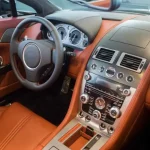Car interiors have undergone a remarkable transformation over the years, reflecting advancements in technology, design trends, and changing consumer preferences. Vintage and modern car interiors represent two distinct eras of automotive design, each with its own unique charm and features.
In this article, we’ll compare car interiors from different eras, highlighting the key differences and the evolution of design and functionality.
1. Materials and Upholster
*Vintage:* In the early days of automotive design, car interiors were characterized by utilitarian materials like cloth, vinyl, and basic carpeting. Leather was a luxury reserved for high-end models.
*Modern:* Modern car interiors often feature a wide range of materials, including premium leather, Alcantara, synthetic suede, and high-quality fabrics. The use of luxury materials has become more common, even in mid-range vehicles, enhancing both comfort and aesthetics.
**2. Dashboard and Controls:**
*Vintage:* Vintage car interiors typically had simple, functional dashboards with analog gauges, knobs, and buttons. Many vintage cars had minimal instrumentation compared to modern vehicles.
*Modern:* Modern car dashboards are a showcase of digital technology. Digital instrument clusters, touchscreen infotainment systems, and intuitive controls have become standard. These advanced systems provide drivers with a wealth of information and entertainment options at their fingertips.
**3. Seating Comfort:**
*Vintage:* Vintage cars often had bench seats or minimalistic bucket seats with limited adjustments. Comfort was not always a top priority in earlier designs.
*Modern:* Modern cars offer a wide range of seating options, including highly adjustable power seats, lumbar support, heating, cooling, and even massage functions. Ergonomics and comfort have become paramount in modern car design.
**4. Safety Features:**
*Vintage:* Safety features in vintage cars were rudimentary compared to today’s standards. Seatbelts, airbags, and advanced crumple zones were not commonplace.
*Modern:* Modern car interiors prioritize safety with the inclusion of multiple airbags, advanced driver-assistance systems (ADAS), adaptive cruise control, blind-spot monitoring, and collision avoidance technology. These features enhance both driver and passenger safety.
**5. Space and Storage:**
*Vintage:* Vintage cars often had limited interior space and minimal storage options. Trunk space was sometimes limited as well.
*Modern:* Modern car interiors are designed for maximum space utilization and practicality. Fold-down rear seats, ample cupholders, and storage compartments are common, catering to the needs of today’s consumers.
**6. Connectivity and Entertainment:**
*Vintage:* Vintage cars had basic AM/FM radios as the primary source of entertainment. Connectivity options were virtually nonexistent.
*Modern:* Modern car interiors are equipped with advanced infotainment systems, Bluetooth connectivity, smartphone integration (Apple CarPlay and Android Auto), and even Wi-Fi hotspots. Entertainment and connectivity options have expanded significantly.
**7. Interior Lighting:**
*Vintage:* Vintage cars featured traditional incandescent bulbs for interior lighting, often with limited customization.
*Modern:* Modern car interiors offer customizable LED ambient lighting with various colors and intensity settings, allowing drivers to create their desired mood and ambiance inside the cabin.
**8. Design Aesthetics:**
*Vintage:* Vintage car interiors often had a more straightforward and functional design. Wood trim and chrome accents were common in luxury models.
*Modern:* Modern car interiors feature a wide range of design aesthetics, from minimalist and sleek to futuristic and high-tech. Manufacturers prioritize creating visually appealing and driver-focused cabin designs.
**9. Sound Systems:**
*Vintage:* Vintage cars had basic audio systems with limited speaker placement and sound quality.
*Modern:* Modern cars often come with premium sound systems from renowned audio brands, offering superior sound quality and speaker placement for an immersive audio experience.
**Conclusion:**
Comparing vintage and modern car interiors reveals the impressive evolution of automotive design and technology. While vintage interiors evoke a sense of nostalgia and simplicity, modern interiors prioritize comfort, safety, technology, and customization. Whether you appreciate the classic charm of a vintage car or the cutting-edge features of a modern vehicle, car interiors have come a long way to meet the ever-changing demands and expectations of drivers and passengers alike.


